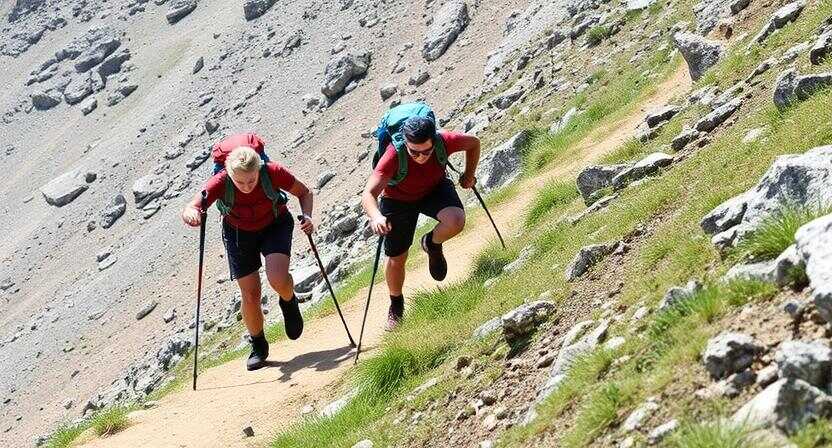
Hiking is one of the best ways to explore nature, challenge your body, and improve your overall fitness. But if you want to enjoy your hikes without exhaustion or injury, proper training is essential. I still remember my first hike up a steep mountain trail. I was excited but completely unprepared. Within 30 minutes, my legs were burning, my heart was racing, and I was gasping for air. Meanwhile, experienced hikers passed me effortlessly. I realized that hiking wasn’t just about putting one foot in front of the other—it required strength, endurance, and preparation. That day, I learned the hard way that training for hiking is just as important as the hike itself.
If you’ve ever struggled on a trail, felt exhausted halfway, or worried about injuries, you’re not alone. In this guide, you’ll learn exactly how to train for hiking, including step-by-step workouts, gym vs. outdoor training comparisons, and essential exercises to build the stamina and strength needed for any hiking adventure—whether it’s a short day hike or a multi-day adventure.
Why Training for Hiking is Important
Many hikers assume they can just hit the trail without preparation, but hiking requires a unique combination of endurance, strength, and balance. Proper training ensures you can hike longer distances, tackle steep inclines, and recover faster without feeling exhausted or risking injury.
Benefits of Hiking Training for Endurance, Strength, and Injury Prevention
- Builds Stamina & Endurance – Long hikes demand sustained energy. Cardio training improves your body’s ability to hike for hours without feeling fatigued.
- Strengthens Muscles & Joints – Hiking involves steep climbs, uneven terrain, and heavy backpacks. Strength training prepares your legs, core, and upper body to handle these challenges.
- Prevents Injuries – Sprained ankles, knee pain, and muscle cramps are common hiking injuries. A structured training plan improves balance, flexibility, and joint stability, reducing the risk of falls or strains.
- Enhances Performance on Trails – The better shape you’re in, the more enjoyable and effortless your hikes will feel. With strong legs, stable knees, and solid endurance, you’ll move more efficiently and recover faster after each trip.
How Hiking Fitness Affects Performance on Trails
Your level of hiking fitness directly affects your performance on different types of trails:
- Steep Inclines & Elevation Gains – Strong quads, glutes, and calves help power you up hills without burning out.
- Rocky & Uneven Terrain – A stable core and strong ankles improve balance and help prevent falls.
- Long-Distance Hiking – A combination of cardio and endurance training ensures you can hike all day without exhaustion.
- Multi-Day & Backpacking Trips – Strength and flexibility reduce strain on your back and shoulders when carrying a loaded pack.
Best Way to Train for Hiking Based on Experience Level
Your hiking training plan should be tailored to your current fitness level to ensure steady progress and injury prevention.
- Beginners – Focus on cardio endurance, lower body strength, and flexibility. Start with brisk walking on flat terrain, stair climbing for elevation training, and bodyweight exercises like squats and lunges. Stretching routines improve mobility and reduce stiffness.
- Intermediate Hikers – Increase intensity by incorporating incline training on a treadmill, weighted hikes with a light backpack, and gym-based strength training. This stage helps build stamina for longer, more challenging trails.
- Advanced Hikers – Train for demanding terrains and high-altitude hikes by including high-intensity interval training (HIIT) for endurance, heavy resistance workouts for strength, and long-distance treks with a fully loaded pack to simulate real hiking conditions.
How to Start Training for a Hike (Beginner’s Guide)
If you’re new to hiking or haven’t been active in a while, start with foundational fitness exercises. The goal is to build cardio endurance, leg strength, and flexibility so your body can handle different terrains and long hiking hours.
Building Your Hiking Fitness Foundation
How to Get in Shape for Hiking
Getting in shape for hiking doesn’t mean you need an intense workout routine. A simple mix of walking, strength training, and stretching can get you trail-ready in a few weeks. Here’s how to start:
- Walk Regularly – Start with 30-minute walks on flat surfaces and gradually increase to 1–2 hours on hilly terrain.
- Incorporate Strength Training – Focus on leg and core workouts to handle steep inclines and uneven ground.
- Improve Flexibility – Regular stretching reduces stiffness and prevents injuries.
- Increase Endurance with Cardio – Running, cycling, or swimming boosts stamina for longer hikes.
Best Workouts for Hiking (Cardio, Strength, Flexibility)
To prepare for hiking, incorporate a balanced mix of cardio, strength, and flexibility exercises. Each type of workout plays a crucial role in improving endurance, stability, and overall performance on the trail.
- Cardio Training – Engage in walking, jogging, cycling, or swimming at least three to four times per week to build endurance. Gradually increase duration and intensity to mimic the sustained effort required for long hikes. Uphill walking and stair climbing are particularly effective for preparing for elevation gains.
- Strength Training – Focus on strengthening the lower body, core, and upper body to improve stability and reduce fatigue. Leg exercises such as squats, lunges, and step-ups help with uphill climbs, while core workouts like planks and Russian twists enhance balance on uneven terrain. Upper body exercises, including shoulder presses and rows, improve backpack-carrying endurance.
- Flexibility & Mobility – Regular yoga, stretching, and foam rolling prevent muscle tightness and improve joint mobility. Targeting the hamstrings, calves, and hip flexors enhances range of motion, reducing the risk of injury and making movements more efficient during hikes.
Best Exercises for Hiking (Step-Ups, Lunges, Squats, etc.)
These key exercises strengthen your legs, core, and stability for hiking:
- Step-Ups – Mimic uphill hiking by stepping onto a bench or platform.
- Lunges – Improve leg strength and balance for uneven terrain.
- Squats – Build lower body power for climbing and descending hills.
- Calf Raises – Strengthen ankles and calves for long hikes.
- Planks & Russian Twists – Build core strength for stability and backpack support.
How to Start a Hiking Training Plan at Home
You don’t need a gym to get in shape for hiking. Try this simple home workout plan:
- 3 Days a Week – Strength Training (squats, lunges, step-ups, planks)
- 3–4 Days a Week – Cardio (walking, running, cycling)
- Daily – Stretching & Mobility Work
Training in the Gym vs. Outdoors
While outdoor hiking is the best training, gym workouts can help you build strength and endurance efficiently. Here’s how to train in both settings.
How to Train for Hiking in the Gym
- Strength Machines – Leg press, hamstring curls, and calf raises build lower body strength.
- Stair Climbers – Great for simulating uphill hiking and improving endurance.
- Treadmill Workouts – Walking at an incline strengthens hiking muscles.
How to Train for Hiking on a Treadmill

- Incline Walking – Set the treadmill to 10–15% incline to mimic steep trails.
- Speed Variations – Alternate between slow, steady walking and short bursts of faster pace to improve endurance.
- Weighted Backpack Walks – Wear a loaded backpack to simulate real hiking conditions.
How to Train for Hiking at the Gym vs. Outdoor Hiking Training
| Factor | Gym Training | Outdoor Training |
| Leg Strength | Strength machines & weights | Natural inclines & step-ups |
| Cardio Endurance | Treadmill, stair climbers | Long hikes, trail runs |
| Balance & Stability | Balance boards, core exercises | Uneven terrain |
| Backpack Conditioning | Weighted exercises | Hiking with a loaded pack |
Both methods are effective, but combining gym workouts with actual hikes gives you the best results.
Training for Specific Hiking Conditions & Challenges
Hiking conditions vary significantly based on location, altitude, and terrain. Whether you’re preparing for a mountain hike, high-altitude trek, long-distance adventure, or steep incline, your training should match the challenges you’ll face on the trail. Below is a detailed guide to help you build the necessary strength, endurance, and resilience for different hiking conditions.
How to Train for Mountain & Elevation Hikes
Hiking in mountainous regions requires strong legs, endurance, and mental toughness. Steep inclines, rocky trails, and unpredictable weather can make mountain hiking exhausting, so preparation is key.
How to Train for Hiking Mountains
Training for mountain hiking requires a balance of strength, endurance, and stability to handle steep inclines and rugged terrain. A well-rounded approach ensures better performance and reduced fatigue on challenging trails.
- Leg Strength – Squats, lunges, and step-ups help develop lower body power, making it easier to climb steep ascents and descend safely without straining the knees.
- Endurance – Long-distance hikes or incline treadmill sessions at a steady pace improve stamina, preparing your body for sustained effort over rough and elevated terrain.
- Cardio Conditioning – Running or cycling enhances lung capacity and cardiovascular endurance, allowing you to maintain a steady pace without excessive fatigue at higher elevations.
- Balance Training – Single-leg exercises and core workouts improve stability on uneven ground, reducing the risk of falls and enhancing overall hiking efficiency.
How to Train for Hiking a 14er
If you’re aiming to hike a 14er (a mountain over 14,000 feet, like those in Colorado), you’ll need to train for altitude, steep ascents, and long durations on the trail. Your focus should be on:
- Gradual Elevation Gain – Start with lower elevation hikes and progress to higher ones.
- Strength & Endurance – Add weighted backpack training to simulate real conditions.
- Hydration & Nutrition – Learn how to fuel your body properly at high altitudes.
How to Train for High Altitude Hiking

Hiking at high altitudes comes with unique challenges like lower oxygen levels, fatigue, and altitude sickness. To prepare, you should train your body to adapt to lower oxygen conditions and build endurance for steep climbs.
How to Train for High Altitude Hiking
- Breathing Techniques – Practice deep breathing exercises to improve oxygen intake.
- Cardio Workouts – Running, swimming, or cycling to strengthen your heart and lungs.
- Elevation Training – Train at high elevations if possible, or use a stair climber with a weighted backpack.
How to Train for Altitude Hiking at Sea Level
If you don’t have access to high-altitude trails, you can simulate altitude training by:
- Using a High-Altitude Mask – These restrict oxygen to simulate altitude conditions.
- Training on a Stair Climber – This mimics the effects of climbing steep inclines.
- Sleeping in a Hypoxic Tent – Some hikers use altitude tents to acclimate before their trip.
How to Train for Long-Distance & Multi-Day Hikes

Long-distance and multi-day hikes demand endurance, muscle recovery, and proper pacing. Training should focus on stamina, backpack weight, and energy conservation.
How to Train for Hiking Long Distances
- Gradually Increase Distance – Start with short hikes and slowly increase to longer distances.
- Backpack Training – Hike with a weighted backpack to condition your body.
- Energy Management – Learn proper pacing and hydration to avoid exhaustion.
How to Train for Multi-Day Hiking
- Strengthen Your Core & Legs – Your body will be under constant strain, so exercises like squats, planks, and lunges are crucial.
- Train with Full Gear – Practice hiking with all your essential gear to get used to the weight.
- Prioritize Recovery – Stretching, foam rolling, and rest days are just as important as training.
How to Train for Uphill & Downhill Hiking

Steep ascents and descents require different sets of muscles. Uphill hiking strengthens your legs and lungs, while downhill hiking puts stress on your knees and joints.
How to Train for Uphill Hiking
- Incline Workouts – Train on hills, stairs, or a treadmill at an incline.
- Leg Power Exercises – Squats, calf raises, and step-ups help build climbing strength.
- Controlled Breathing – Learning how to breathe efficiently can prevent early fatigue.
How to Train for Downhill Hiking
- Quad Strengthening – Downhill hikes put stress on your quads, so include step-downs and lunges in your training.
- Joint Protection – Strengthen your knees with low-impact exercises like cycling or swimming.
- Balance Drills – Core exercises like planks and single-leg deadlifts improve stability.
Training for Specific Trails & Destinations
Some famous hiking destinations have unique challenges such as high altitude, extreme weather, or rugged terrain. Below are destination-specific training plans to help you prepare.
How to Train for Popular Hiking Destinations
How to Train for Hiking the Grand Canyon Rim to Rim
This hike involves steep descents and ascents over long distances. To prepare:
- Train for long hikes with elevation changes.
- Strengthen your quads and knees for downhill sections.
- Hydration and electrolyte balance are critical due to heat exposure.
How to Train for Hiking Mt. Kilimanjaro
- Altitude Acclimation – Train with breathing techniques and endurance workouts.
- Multi-Day Endurance – Practice hiking on consecutive days to build stamina.
- Gear Familiarity – Train with hiking poles and a loaded backpack.
How to Train for Hiking the Appalachian Trail
- Long-Term Endurance – Hike frequently to prepare for months of continuous hiking.
- Pack Weight Training – Practice carrying at least 30 lbs of gear.
- Weather Adaptation – Train in varied weather conditions.
Location-Specific Hiking Training
How to Train for Hiking in Colorado
Colorado’s trails are high-altitude and rocky. Your training should focus on:
- Altitude Acclimation – Spend time at high elevations before your trip.
- Technical Hiking Skills – Train on rocky terrain to improve balance.
- Cold Weather Preparation – Learn how to hike in wind and snow.
How to Train for Hiking in National Parks
National parks have diverse terrains—from desert landscapes to forested mountains.
- Research the specific trail difficulty and climate.
- Train for rocky or uneven surfaces to avoid injuries.
- Build general endurance and strength for long hikes.
Strength & Endurance Training for Hikers
Hiking challenges your entire body, requiring a balance of strength, endurance, and stability. To prevent injuries and improve performance, you must train key muscle groups, build stamina, and follow a structured fitness plan.
Targeting Key Muscle Groups for Hiking

Hiking works multiple muscle groups at once, but legs, knees, and core play the most crucial role. Below is a breakdown of how to train effectively.
How to Train Legs for Hiking
Your quads, calves, and hamstrings do most of the heavy lifting on the trail. Strengthening these muscles will improve endurance and prevent fatigue.
- Step-Ups – Mimic uphill climbing by stepping onto a box or bench.
- Lunges – Improve balance and strength, focusing on quads and hamstrings.
- Calf Raises – Strengthen lower leg muscles for stability on uneven terrain.
- Squats – Boost overall lower body strength.
How to Train Knees for Hiking
Knee pain is one of the most common hiking injuries, especially on steep descents. To keep your knees strong:
- Wall Sits – Build endurance in quads and knees.
- Single-Leg Balances – Improve stability and prevent knee injuries.
- Glute Bridges – Strengthen your hip muscles to reduce knee strain.
- Foam Rolling – Helps release tension in tight leg muscles that stress the knees.
How to Train Stamina for Hiking
Hiking long distances requires good cardiovascular fitness. To build stamina:
- Incline Walking – Use a treadmill or hike on gradually steeper trails.
- Trail Running – Boosts endurance and strengthens ankles and core.
- Jump Rope – A simple but effective way to improve lung capacity.
How to Train Your Body for Hiking
For full-body strength and endurance, include:
- Core Workouts – Planks and Russian twists help with balance on uneven ground.
- Upper Body Strength – Strong shoulders and back support a heavy backpack.
- Flexibility Training – Yoga and stretching prevent injuries and improve mobility.
Hiking Classes & Courses
If you’re new to hiking or want expert guidance, consider hiking classes and structured training programs.
Hiking Classes & Hiking Courses – Are They Worth It?
Hiking courses teach techniques, navigation, survival skills, and fitness training. Some focus on beginner-friendly hikes, while others help experienced hikers prepare for high-altitude or multi-day treks.
Popular courses include:
- REI Hiking Classes – Cover everything from basic hiking skills to advanced backpacking techniques.
- Online Hiking Training Programs – Provide custom fitness plans and expert guidance.
Best Structured Hiking Training Programs
For a step-by-step approach to hiking fitness, consider:
- Alpine Ascents Mountaineering Training – Focuses on mountain hiking and elevation gains.
- Backpacking-Specific Fitness Plans – Help you train for carrying a heavy pack over long distances.
Training for Special Cases (Dogs, No-Hike Training, etc.)
Not everyone has access to hiking trails for training, and some hikers want to bring their dogs. Here’s how to train for special cases.
How to Train for Hiking Without Hiking
If you can’t train on a trail, you can still build hiking strength indoors.
How to Train for Hiking Without Hiking
- Stair Climbing – A great alternative to uphill hiking.
- Treadmill Incline Walks – Simulate steep ascents.
- Strength Circuits – Use bodyweight exercises like lunges, squats, and step-ups.
How to Use Running to Train for Thru-Hiking
Running is a great way to boost endurance, but it’s not a perfect substitute for hiking. If you plan to use running as part of your training:
- Combine Running with Strength Training – Running improves cardio, but hiking requires leg and core strength.
- Use Trail Running – This helps train your ankles and legs for uneven terrain.
How to Train Your Dog for Hiking

Bringing a dog on a hike requires training them for endurance, obedience, and trail safety.
How to Train a Dog for Hiking
- Start with Short Walks – Build up their stamina gradually.
- Obedience Training – Teach commands like “stay,” “come,” and “leave it”.
- Trail Exposure – Get them used to different surfaces like rocks, dirt, and water crossings.
How to Train a Dog for Hiking and Backpacking
- Condition Their Paws – Train on rough terrain so their paws toughen up.
- Use a Dog Backpack – Start with light loads and gradually increase weight.
- Hydration & Nutrition – Always carry extra water and food for your dog.
Sample Hiking Training Plan (4–8 Weeks)
A structured hiking training plan helps you build strength and endurance over time. Here’s a week-by-week guide for beginners and experienced hikers.
Week 1–2: Build the Foundation
- Cardio: 3–4 days of incline walking or jogging (30–40 minutes).
- Strength Training: 2 days of bodyweight exercises (squats, lunges, step-ups).
- Core & Balance: Planks, side planks, and single-leg balances.
Week 3–4: Increase Intensity
- Cardio: Add 1 day of stair climbing or hill sprints.
- Strength Training: Use light weights for squats and lunges.
- Long Hike: 1 hike of at least 5–7 miles with a light backpack.
Week 5–6: Trail Readiness
- Cardio: Increase hiking or treadmill incline walks to 45–60 minutes.
- Strength Training: Add weighted backpack training to squats and lunges.
- Long Hike: Hike with gradually heavier packs and steeper inclines.
Week 7–8: Peak Training
- Cardio: Hike at least 8–10 miles once a week.
- Strength Training: Focus on stability and endurance.
- Recovery: Stretch, foam roll, and get enough rest between sessions.
Conclusion
Training for hiking is about building strength, endurance, and stamina while preparing for the specific challenges of the trail. Whether you’re training at home, in the gym, or on real trails, a structured approach ensures you hike efficiently and injury-free.
By following the training plans, strengthening key muscles, and preparing for different terrains, you’ll feel confident and ready for your next adventure.
FAQs – Answering Common Hiking Training Questions
How Many Weeks Are Needed to Train for Hiking Up Mountains?
It depends on the difficulty of the hike. For moderate hikes, 4–6 weeks of training is enough, but for steep mountain hikes or 14ers, plan for at least 8–12 weeks.
What’s the Best Way to Train for Hiking?
The best approach includes:
- Cardio Workouts – For endurance.
- Strength Training – To handle steep terrain.
- Balance & Core Workouts – To prevent falls and injuries.
Do I Need a Gym for Hiking Training?
No! You can train at home using bodyweight exercises, stairs, and outdoor trails. However, a gym can help with incline treadmills and weight training for extra strength.
Ethan Marlowe is an experienced hiker and outdoor gear specialist based in Colorado. With over 7 years of hands-on experience trekking through the Rockies, Pacific Northwest, and East Coast trails, he delivers practical advice, expert gear reviews, and survival insights. His goal is to help hikers of all levels make smarter decisions on and off the trail.


